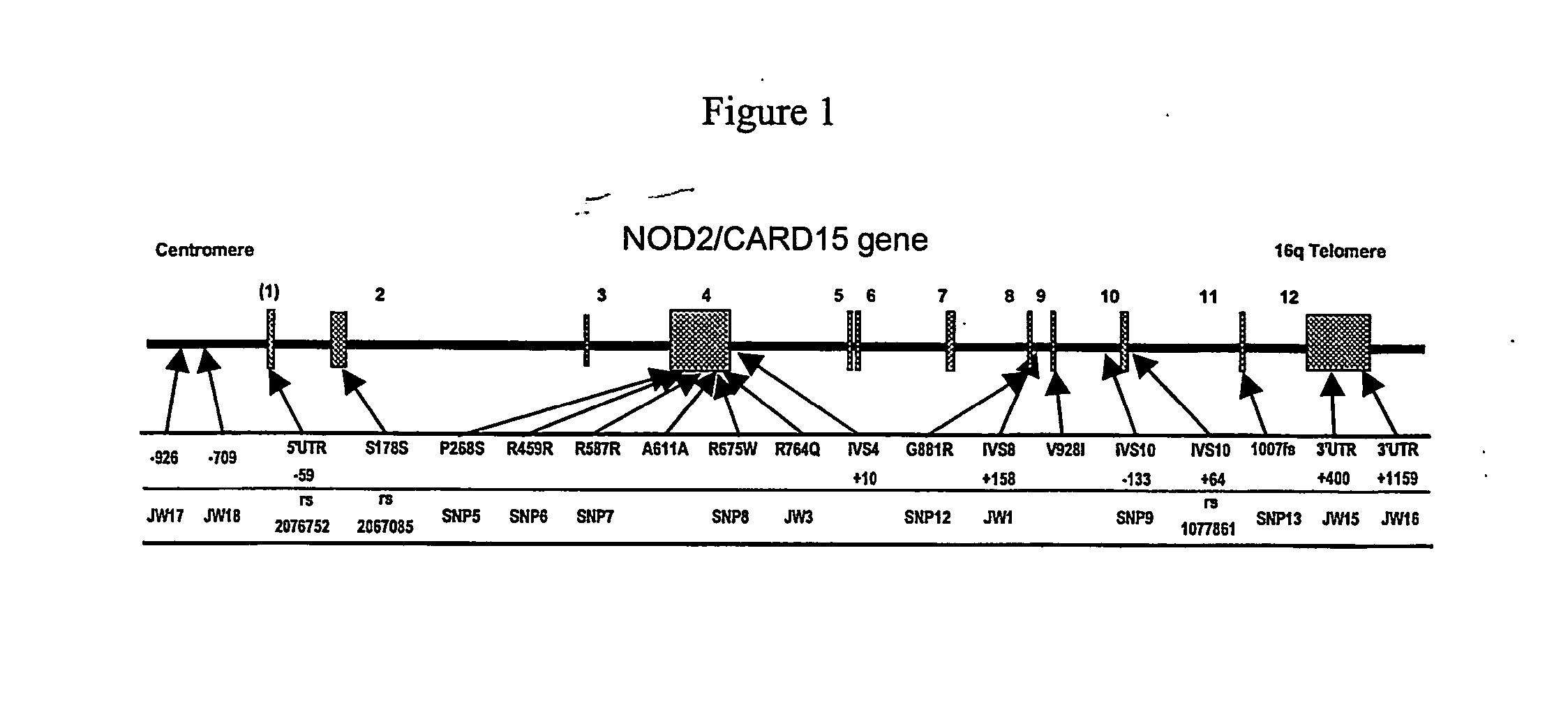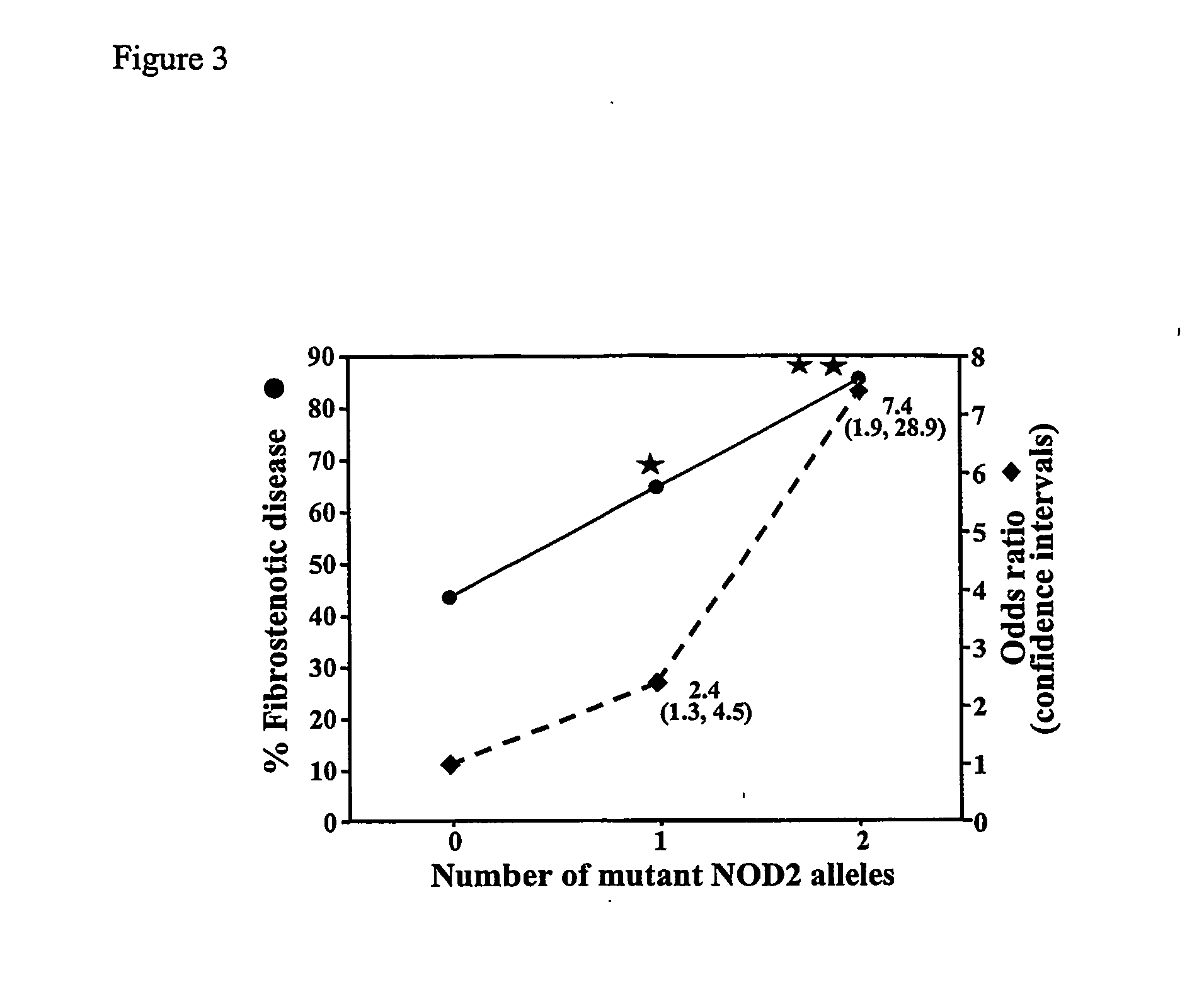Mutations in nod2 are associated with fibrostenosing disease in patients with crohn's disease
a technology of nod2 and fibrostenosis, which is applied in the field of gene therapy and autoimmune diseases, can solve the problems of delay in optimal treatment and increased risk of intestinal cancer in patients with ibd, and achieve the effect of diagnosing or predicting susceptibility
- Summary
- Abstract
- Description
- Claims
- Application Information
AI Technical Summary
Benefits of technology
Problems solved by technology
Method used
Image
Examples
example i
Selection and Characterization of Study Subjects
[0091] This example describes the clinical characterization of how two cohorts of Crohn's disease patients.
A. Selection of Study Subjects
[0092] Two cohorts of Crohn's disease patients were consecutively identified from an inflammatory bowel disease referral center (Cedars-Sinai Medical Center Inflammatory Bowel Disease Center). The first cohort of 142 patients, ascertained between 1993-1996 and designated “CD1”, was previously described in Vasiliauskas et al., Gut 47:487-496 (2000)). The second cohort of 59 patients (Cohort 2) was collected between 1999-2001 and designated “CD2”. A cohort of 175 patients with ulcerative colitis was used as an inflammatory bowel disease control group. This study, which was reviewed and approved for human subject participation by the Cedars-Sinai Institutional Review Board, involved the collection of clinical, serologic and genetic data from patients consenting to the study.
[0093] A diagnosis of Cro...
example ii
Patients with Crohn's Disease Have an Increased Frequency of Rare Allelic Variants of NOD2 / CARD15
[0098] This example describes the association of a “2” allele at SNP 8, SNP 12, or SNP 13 within the NOD2 / CARD15 locus (rare allelic variants of NOD2 / CARD15) with Crohn's disease in a North American population.
[0099] In order to determine whether the North American Crohn's disease patient populations in Cohorts 1 and 2 expressed allelic variants of NOD2 / CARD15, Cohort 1 (hypothesis-generating) and Cohort 2 (hypothesis-confirming) were genotyped for the rare allelic variant of SNP 8 (R675W), SNP 12 (G881R) and SNP 13 (3020insC). A cohort of ulcerative colitis patients was used for comparison.
[0100] Genotyping was performed using a genotyping assay employing 5′-exonuclease technology, the TaqMan MGB™ assay (PE Biosystems; Foster City, Calif.). Primers were designed using the software PrimerExpress 1.5™ (PE Biosystems) and sequence information found in dbSNP for NOD2 / CARD15 SNP 5, 8, 12,...
example iii
Rare Variant Alleles in the NOD2 / CARD15 Locus are Associated with the Fibrostenosing Subtype of Crohn's Disease in Cohort 1
[0104] This example demonstrates that a “2” allele at SNP 8, SNP 12, or SNP 13 is significantly associated with fibrostenosing disease in Cohort 1.
[0105] Patients with Crohn's disease express diverse clinical phenotypes that can be due to differences in underlying genetic factors. In order to determine whether rare variant alleles at the NOD2 / CARD15 locus were associated with specific Crohn's disease-related clinical phenotypes or disease-related serum immune markers, univariate analysis was performed. The univariate analysis evaluated the association between NOD2 / CARD15 allelic variants at SNP 8, SNP 12, or SNP 13 and predefined clinical characteristics, including age of onset, disease location, and disease phenotype (fibrostenosing disease, internal-perforating disease, perianal fistulizing disease or ulcerative colitis-like disease). The association between...
PUM
| Property | Measurement | Unit |
|---|---|---|
| weight loss | aaaaa | aaaaa |
| frequency | aaaaa | aaaaa |
| allelic frequencies | aaaaa | aaaaa |
Abstract
Description
Claims
Application Information
 Login to View More
Login to View More - R&D
- Intellectual Property
- Life Sciences
- Materials
- Tech Scout
- Unparalleled Data Quality
- Higher Quality Content
- 60% Fewer Hallucinations
Browse by: Latest US Patents, China's latest patents, Technical Efficacy Thesaurus, Application Domain, Technology Topic, Popular Technical Reports.
© 2025 PatSnap. All rights reserved.Legal|Privacy policy|Modern Slavery Act Transparency Statement|Sitemap|About US| Contact US: help@patsnap.com



